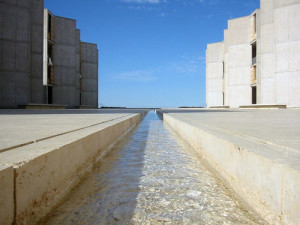
Louis Isadore Kahn (March 5, 1901–March 17, 1974) was born as Itze-Leib Schmuilowsky in Estonia where at the age of 3 he permanently scarred his face while playing with coals from a stove. His father, fearing being recalled into the Russian Army for the Russo-Japanese War, immigrated to the United States with his family in 1906, becoming a naturalized citizen in 1914 and changing the family name to Kahn in 1915.
Louis was an indifferent student at Philadelphia Central High School until his senior year when a course in architecture ignited his interest. At the University of Pennsylvania School of Fine Arts, Kahn studied under Paul Philippe Cret, who discouraged excessive ornamentation. Kahn received a bachelor of architecture degree in 1924, then worked as a senior draftsman in the office of the city architect, helping to develop designs for Philadelphia’s 1926 Sesquicentennial Exposition. In 1928. Kahn toured western Europe, paying particular attention to castles and walled cities.
In the 1930s Kahn collaborated with George Howe on projects for the Philadelphia Housing Authority, and in 1940 with Oscar Stonorov for housing developments in other parts of Pennsylvania. Stonorov and Kahn were architectural partners between 1942 and 1947, producing 54 documented projects and buildings. He began teaching at Yale University in 1947 and transferred in 1956 to the Massachusetts Institute of Technology, moving again a year later to the University of Pennsylvania where he remained until his death. He also was a visiting lecturer at Princeton University School of Architecture from 1961 to 1967.

From 1958 through 1965, he collaborated with biologist Jonas Salk on what some have described as his defining work, the Salk Institute for Biological Studies in La Jolla. The architecture, sometimes described as brutalism, emphasized the cement and wood materials used in its construction. The laboratory cluster, consisting of two parallel blocks, frame a long view of the Pacific Ocean, accentuated by a thin linear fountain that seems to reach for the horizon.
Other notable Kahn projects include the First Unitarian Church of Rochester, New York; the Shaheed Sihrawardy Medical College and Hospital in Dhaka, Bangladesh; the Phillips Exeter Academy Library in Exeter, New Hampshire; the Kimbell Art Museum in Fort Worth, Texas; the Yale (University) Center for British Art; the Franklin D. Roosevelt Four Freedoms Park on Roosevelt Island, New York, and his last project, the National Assembly Building in Bangladesh.
Kahn and his wife Esther had a daughter, Sue Ann. Anne Tyng, an architectural associate with whom he had an affair, gave birth to another daughter, Alexandra. And with Harriet Pattison, a landscape architect with whom he had another affair, he had a son, Nathaniel, whose documentary My Architect: A Son’s Journey was nominated for an Oscar.
Tomorrow, March 6: Rob Reiner
*
SDJW condensation of a Wikipedia article.
Thank you for reminding us about this great architect.